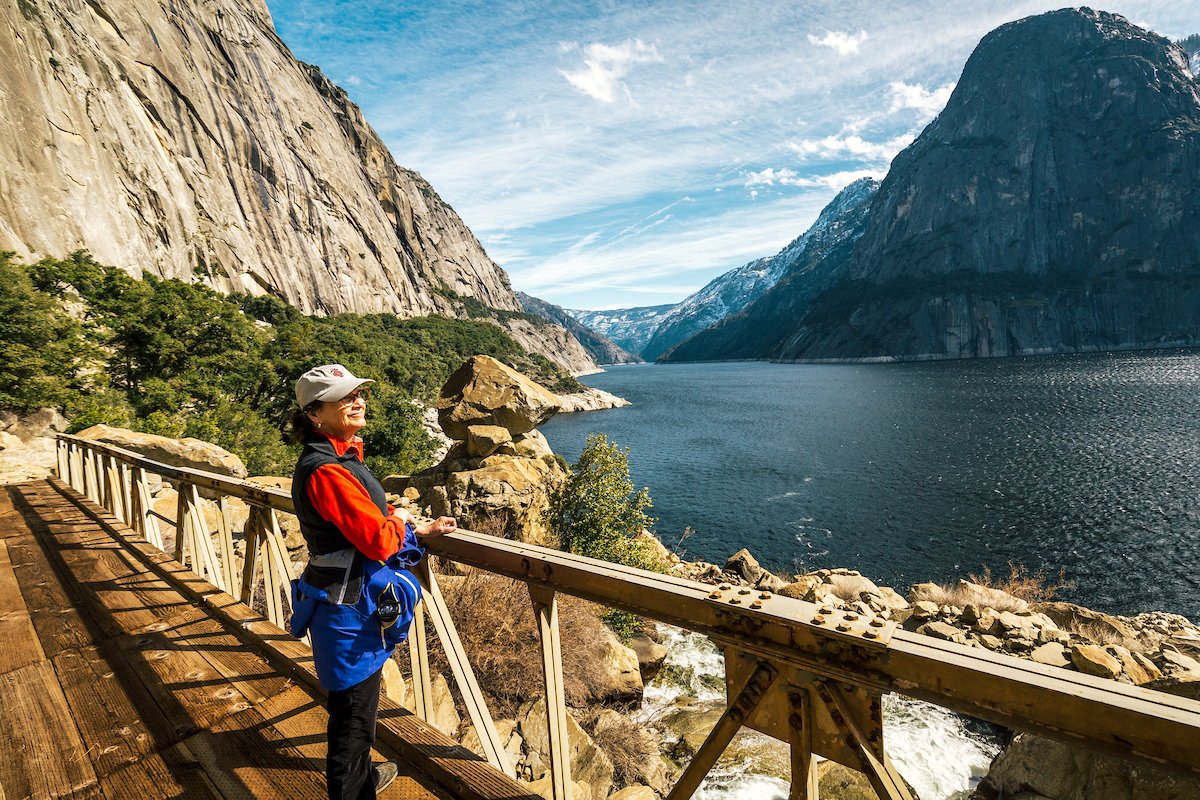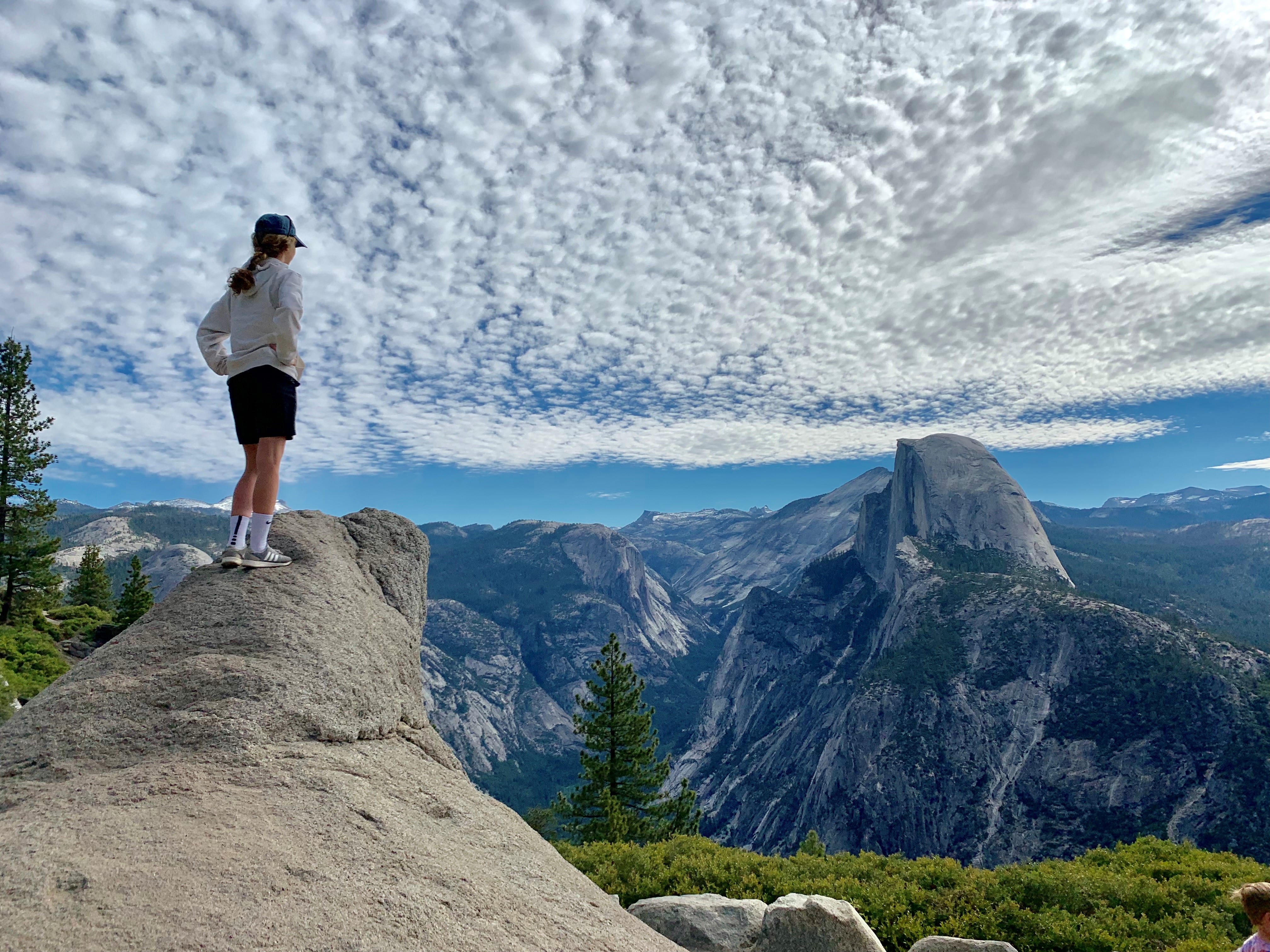One of the best times to drive through Yosemite is from May/June through early autumn. During the cooler months, from November through April, several roads are closed for the winter and weather during this time of year may affect driving conditions on other roads.
While many visitors come to Yosemite National Park for day hiking, rocking climbing and white water rafting, some are unaware of the beautiful scenic drives that Yosemite offers.
As you begin researching the best time to visit Yosemite and planning your next vacation, allow us to add a few scenic drives to your itinerary that are sure to exceed your expectations.
Best Scenic Drives In Yosemite
Tioga Pass
One of the most famous drives through Yosemite will take you from one side of the park to the other. From the Big Oak Flat Entrance to the Tioga Pass Entrance is just over 54 miles along Hwy 120. Driving straight through takes around one and a half hours, but we recommend adding a few scenic lookouts along your route.
Whether you enter from the west or the east of the park, you are immediately greeted with jaw-dropping views. Within the first ten miles of your drive, after entering the Big Oak Flat Entrance, you will pass the Merced and Tuolumne Groves. These are two giant sequoia groves that can easily be reached with a quick hike. Remember, the trees you see lining Tioga Pass Road may seem tall, but once you stand at the base of a mature sequoia, you’ll understand what all the fuss is about.
Did you remember to fill up your gas tank before heading out on your drive through Yosemite? There is a convenient fill-up station on each end of Tioga Pass. On the west side, there’s a Chevron gas station located 8 miles from the Big Oak Flat Entrance between the Merced and Tuolumne Groves. On the east side of Tioga Pass, about 12 miles before the entrance, travelers will find a Mobile gas station near the end of Hwy 120 in Lee Vining. Locals love the Mobile for its Mango Margaritas and surprisingly delicious gourmet food offerings.
If you plan to enter Yosemite National Park from the east, you will have the chance to experience a portion of Hwy 120 that isn’t within the park’s borders and offers a vastly different landscape than the one found at the west entrance. Rather than finding towering trees and thick woods, you’ll encounter a winding road with a deep valley on your left and rigged rock-covered mountainsides on your right. When you see the sign reading “PARK ENTRANCE ¼ MILE,” you will notice the trees surrounding the road begin to thicken, but the expansive granite monoliths continue for miles in the distance.
After driving through the Tioga Pass Entrance, you will immediately see a small parking lot to your right. This is the trailhead for Gaylor Lakes and Gaylor Peak. To your left, Mt. Dana towers in the distance. As you travel along Tioga Pass, you will drive in and out of thick woods and open meadows with numerous trailhead parking lots and lookout points scattered throughout. A few of the most famous scenic stops on Tioga Pass are Olmsted Point, Tenaya Lake and Tuolumne Meadows.
Remember, Tioga Pass is only accessible from late spring to early fall due to snow. Check the Winter Road Closures page on the National Park Services website for opening and closing dates if you are planning a visit in the spring or fall.

Hetch Hetchy
The entrance to Hetch Hetchy is located just 2 miles from the Evergreen Lodge. From the Hetch Hetchy Entrance to the main parking area at the Reservoir is about 10 miles one way and will take you about 20 minutes if you are driving with no stops.
Just before the Hetch Hetchy entrance, you will drive around a sharp curve in the road that leads you deeper into Yosemite’s forests. This drive is another typical Yosemite road, winding back and forth with steep valleys and towering granite monoliths on either side. For a portion of your drive, the only signs of civilization you will encounter are the paved road, a few speed limit signs and a portion of power lines running through the valley on your left.
While this drive is much shorter than others on our list, you’ll have plenty of time to explore the Hetch Hetchy Reservoir and surrounding trails if you choose to take this drive through Yosemite. Evergreen Lodge offers a guided tour of the area that gives hikers a history of the reservoir and O’Shaughnessy Dam along with a guided hike to Wapama Falls and back. The tour lasts around 4.5 hours and includes trekking pole rentals, a lunch voucher for use at Evergreen’s General Store and admission and transportation to the park.
If you don’t have time to explore the trails or book a tour during your Hetch Hetchy drive, you must take time to walk across the O’Shaughnessy Dam. The views of the valley below are truly breathtaking. No matter what season you visit, Hetch Hetchy is a gem of Yosemite National Park you won’t want to miss.

Glacier Point
The start to this scenic drive through Yosemite is located about halfway between the South Entrance (16.9 miles) and Arch Rock Entrance (15.7 miles). Depending on where you will be entering the park, this route could easily be combined with the Yosemite Valley drive or Mariposa Grove drive (discussed below).
Once you turn onto Glacier Point Road, the route to the top of Glacier Point is just under 16 miles and will take you about 30 minutes with no stops. For the first couple of miles, the road is surrounded on either side with towering trees, but as the trees clear, you will be granted an expansive vista of the valley below. If you are making the Glacier Point drive during spring, be on the lookout for lingering snow amid the thick forest. These crisp (and not so crisp) white patches will catch your eye among the lush green underbrush.
Along the way, you will pass the Yosemite Ski & Snowboard Area (formerly known as Badger Pass). There are also several trailheads including McGurk Meadow, Ostrander Lake, Mono Meadows and Taft Point/Sentinel Dome (two trails branching off one trailhead). You will know you are almost to your destination when you begin the sharp winding descent down the mountain and find Washburn Point. This is a must-see lookout that gives travelers their first view of Half Dome and the Vernal and Nevada Falls in the distance.
If you find Washburn Point a little too crowded, just a half of a mile up the road is Glacier Point Curve Vista, with another awe-inspiring view of Half Dome and the surrounding valley. This lookout is only 0.2 miles from the end of your driving journey where even more photo opportunities are found.
Once you reach the end of Glacier Point Road, there are endless options from which you can take the perfect photo of Half Dome. You’ll also find an outdoor amphitheater and a museum. If you want to see the best views Glacier Point has to offer, follow the trail half of a mile to the highest point. From here, you will have an incredible bird’s eye view of Yosemite Valley below, Yosemite Falls towering over the Valley and Half Dome’s flat face to the east.
Remember, Glacier Point Road (starting at the Yosemite Ski Area) closes from early fall to late spring due to snow. Check the Winter Road Closures page on the National Park Services website for opening and closing dates if you are planning a visit in the spring or fall.

Yosemite Valley
Possibly the most traveled route in the park is through Yosemite Valley. You can enter the Valley via Wawona Road (24.6 miles from South Entrance), El Portal Road (5 miles from Arch Rock Entrance) or Big Oak Flat Road (17.5 miles from Big Oak Flat Entrance), which merges with El Portal Road near the Valley’s entrance. Simply driving into the Valley and back out is around 14 miles (depending on the entrance route you choose) and takes approximately 30 minutes, but travelers can easily make an entire day out of their drive through Yosemite Valley, stopping at each of the lookouts and taking time to explore.
We recommend entering the Valley via Wawona Road since this route gives you the best first view. You will know you have arrived when you see the entrance to Wawona Tunnel. This man-made marvel was completed in 1933 after 3 years of construction and 275 tons of explosives. The Wawona Tunnel is the longest in California at just under a mile. When you reach the end of the tunnel, you will be greeted by the infamous Tunnel View, a scene that is known by many from the photographs of Ansel Adams. You’ll see Bridalveil Falls on the right, El Capitan on the left and Half Dome further in the distance.
Your first views of Yosemite Valley will include picturesque forests and glimpses of lofty granite monoliths. When you hear the word Valley, you may picture a wide-open space with mountains bordering the edges. This isn’t the case in Yosemite Valley. It’s as if the Valley will only give a peek of each marvelous wonder a little bit at a time. During your drive, you will have sections of open meadows with rippling rivers and others of thick forests with only peepholes of the surrounding monoliths. This is part of what makes Yosemite so special. There are literally millions of picturesque scenes.
Just under 2 miles from Tunnel View, you’ll find the Bridalveil Falls trailhead. The 0.5-mile paved trail meets the base of the 620-foot high falls for a truly stunning sight. Learn more about Bridalveil Falls Trail closures, parking, and more.
After you pass Bridalveil Falls, Wawona Road ends and you will merge onto Southside Drive, the main road into the Valley. As you continue, El Capitan stands prominently on the left, dominating the skies, and the El Capitan Meadow lies below. This spot is great for a picnic and taking some incredible photos. Many sightseers love to scan the side of the 3,000-foot tall granite monolith for extreme rock climbers making their way to the top.
Note, the best access to the meadow and surrounding trails is actually found on the road exiting the Valley. The Merced River lies between these two roads, and the NPS recommends travelers only enter and exit the river where sandy beaches are found.
The first of these sandy beaches you will encounter is Cathedral Beach. There are picnic areas, trails and travelers love to capture the reflection of El Capitan in the Merced River. Other beaches in the Valley include Sentinel Beach and Sandy Beach. Continuing the drive into Yosemite Valley, travelers will pass the Four Mile trailhead, Swinging Bridge, Yosemite Valley Chapel, and the Yosemite Conservation Heritage Center.
You’ll come to the intersection of Southside Drive, Northside Drive, Happy Isles Loop Road and Curry Village Drive. Taking a right leads to Curry Village where there’s a restaurant, bike rentals and raft rentals. Going straight leads to the Pines Campground, Tenaya Canyon and the John Muir Trail. Take a left onto Northside Drive, and you’ll continue your drive through Yosemite Valley.
After crossing over the Merced River you will see a round-about where you can take a left onto Village Drive. This road leads to the Yosemite Valley Visitors Center, the Village Store & Grill, a couple of other restaurants, the Yosemite Wilderness Center, the Yosemite Museum and the Ansel Adams Gallery. Jump back on Northside Drive and as you drive towards the valley’s exit, you will pass the Upper and Lower Yosemite Falls trailheads, the start of Cook’s Meadow Loop and Yosemite Valley Loop, El Capitan picnic area and incredible up-close views of El Capitan.
Take note that the main roads in and out of the Valley are one way. You will enter via Southside Drive and exit via Northside Drive, but there are several connecting roads throughout the Valley so travelers can easily navigate. Some of these routes are changed during the winter months, so be sure to check with the Park Rangers at the gate for the most current road closures and conditions.
Mariposa Grove
Our last scenic drive through Yosemite is found at the southern tip of the park at the most famous Grove of Giant Sequoias in Yosemite. From the South Entrance, the drive to the grove only takes about 10 minutes, but the rules for driving this route have changed in recent years. In 2015, Mariposa Grove underwent a large-scale restoration project. This undertaking was bankrolled by the Yosemite Conservancy, a nonprofit dedicated to the preservation of Yosemite National Park and its resources. The Mariposa Grove reopened in 2018 with new operational guidelines in place to protect and improve the natural and cultural resources of the giant sequoia habitat while still providing a quality visitor experience.
When you enter the South Entrance of Yosemite National Park, you’ll find Mariposa Grove Road to the right. Visitors are now required to park at the Mariposa Grove Welcome Plaza, located approximately two-tenths of miles from the South Entrance. A free shuttle transports guests from the Welcome Plaza to the Arrival Area. Guests with a disability (whose vehicle displays a disability placard or license plate) are permitted to drive on Mariposa Grove Road to the Arrival Area.
Get all the latest information about Mariposa Grove shuttle operations including closures and shuttle stops.
Whether you decide to make the journey to Mariposa Grove on foot, bicycle or shuttle (once services return), the Mariposa Grove “drive” is approximately four miles roundtrip. The road bends and curves, as most do in Yosemite, surrounded by oaks, pines and cottonwoods on each side. There are a few lookouts along the way where you can easily take a moment to enjoy the view of the surrounding monoliths. As you near Mariposa Grove, you will notice the trees growing taller and wider. To the right, you’ll see the sign “ENTERING MARIPOSA GROVE OF GIANT SEQUOIAS.”
The main Mariposa Grove Trail leads hikers throughout the grove seeing the most well-known giants like the Bachelor & Three Graces, the Grizzly Giant, the California Tunnel Tree and the Faithful Couple. Check out the NPS website for a handy map of the grove’s trails.
Do you know why visitors are not allowed to stand at the base of giant sequoias at Yosemite National Park? Contrary to what you might think, a giant sequoia’s root system only reaches into the soil around four or five feet in depth. The real strength of giant sequoia’s roots is found in the tiny, threadlike feeders that spread out from the larger roots and surround the base of the tree. The taller a giant sequoia grows the wider its root system becomes. This is why barricades are placed around the base of each sequoia, protecting the delicate foundation that supports these towering giants.
Mariposa Grove is another road that closes during the winter months due to snowfall. Visitors are still welcome to visit the Grove with snowshoes, but this is only recommended for experienced hikers. Please note, if you are staying at one of our Yosemite Hotels, it’s best to plan a full-day excursion to the Mariposa Grove or combine this drive through Yosemite with another like Yosemite Valley. The drive from Rush Creek Lodge to the Mariposa Grove Welcome Plaza takes approximately one and a half hours.
**Insider Tip** Less than 20 minutes from Rush Creek Lodge are two lesser-known gems. Just inside the Big Oak Flat Entrance, the Tuolumne and Merced Groves are found. Both groves are an approximate one-half-mile hike from the road, and it is here you will find the first man-made Tunnel Tree in Yosemite National Park, carved in 1878. Stop by our Recreation Desks for more free local expert planning advice and insider information!
FAQs About Driving Through Yosemite
Can you drive the 120 through Yosemite?
Yes. According to the NPS website, drivers are permitted to drive through the park without paying a fee. A time-stamped pass is provided that allows for enough time to make it from one end of the park to the other along the fastest route. Stopping for photos along the way is not permitted.
Do you need a reservation to drive through Yosemite?
Reservations are not currently required. However, we recommend checking the Yosemite National Park FAQs before your visit in case this changes.
Can you drive through Yosemite in a day?
Yes, you can drive through Yosemite National Park in a day and see all the great sights from your car, BUT merely driving through the park only gives you a small portion of its beauty. Check out our recommendation of how many days you should spend in Yosemite.
What is the main entrance into Yosemite?
The Big Oak Flat Entrance on Hwy 120 is considered the main entrance into the park. This entrance is only 1 mile from Rush Creek Lodge & Spa, the newest resort in the area.
How far is it from San Francisco to Yosemite National Park?
From downtown San Francisco to the Big Oak Flat Entrance of Yosemite National Park is 167 miles and will take approximately 3 hours and 20 minutes to drive.
What is the closest town to Yosemite?
From the South Entrance:
- Fish Camp – 2.4 miles via Hwy 41 S
From the Arch Rock Entrance:
- El Portal – 8.6 miles via El Portal Road
From the Tioga Pass Entrance:
- Lee Vining – 12.7 miles via Hwy 120 E
From the Big Oak Flat Entrance:
- Groveland – 24.1 miles via Hwy 120 W
From the Hetch Hetchy Entrance:
- Groveland – 28.1 miles via Hwy 120 W
What can you do in Yosemite without a day pass?
When day pass reservations are required, there are ways you can enter Yosemite National Park without a pass. First, the Hetch Hetchy area of Yosemite does not require reservations any time of year. Access to this area is tied to parking availability. Next, the YARTS bus runs throughout the year in and out of the park. Taking this transportation into the park does not require individuals to obtain a reservation. Lastly, travelers can book a professionally guided tour with Rush Creek Lodge or Evergreen Lodge, which includes your entrance into the park.
How much does it cost to get into Yosemite?
According to the NPS, the entrance fee for non-commercial vehicles, RVs and large vans (with 15 or fewer passengers) is $35 per vehicle. The entrance fee for motorcycles is $30 per motorcycle, and the fee for bicyclists, horseback riders and walkers is $20 per person.
How long does it take to drive through Yosemite?
Depending on traffic, it typically takes 30 minutes to drive through Yosemite Valley. However, you can easily make a full day of your drive through Yosemite thanks to the many sights and hiking opportunities along the way.
Is the drive to Yosemite steep?
If you’re driving to Yosemite via Highway 120, this road ascends to over 2,500 feet in just an 8-mile section between Tioga Pass and US 395.

